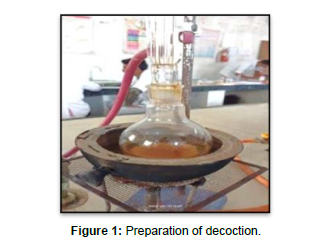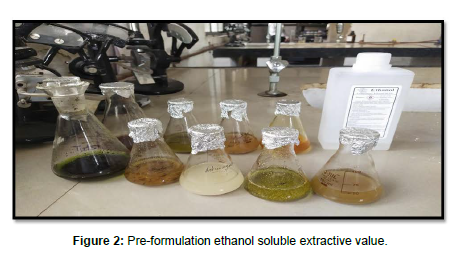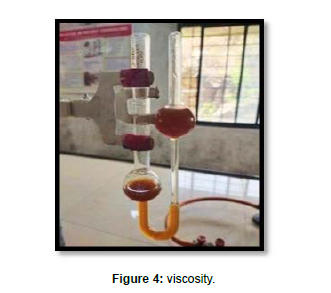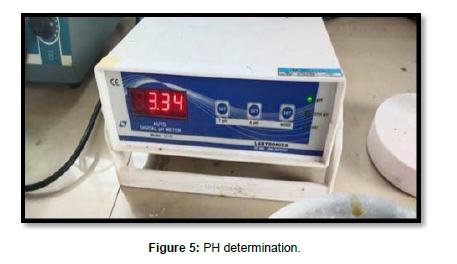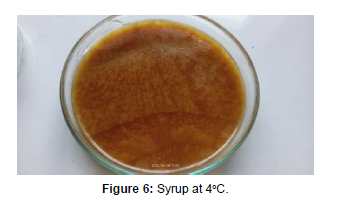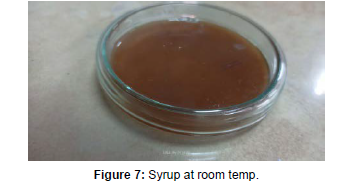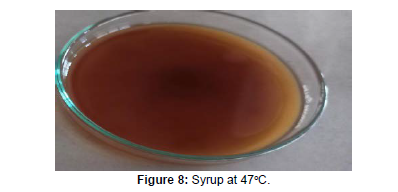Formulation and Evaluation of Herbal Jaggery Base Immune-Booster
Received: 01-Jul-2022 / Manuscript No. jabt-22-70528 / Editor assigned: 04-Jul-2022 / PreQC No. jabt-22-70528(PQ) / Reviewed: 18-Jul-2022 / QC No. jabt-22-70528 / Revised: 22-Jul-2022 / Manuscript No. jabt-22-70528(R) / Published Date: 29-Jul-2022 DOI: 10.4172/2155-9872.1000470
Abstract
Immunity is a human body’s ability to recognize germs to prevent them from causing illness. Very speedily expanded disease in past days is covid-19 caused at least 3 million, excess death in 2020. It infected over 82 million people worldwide, and it mainly affects respiratory system. As per the ministry of Ayushguidelines suggested that to take “Herbal health drinks” like immunity booster syrup. Syrup contains all the herbal drugs which show immunity boosting and health benefits activity, like ashwagandha, tulsi, giloy, amla, ginger, fennel and turmeric etc. also contain a main ingredients jaggery which added in liquid form it act as a good immunity booster and base of syrup also. Jaggery is also act as a good preservative to preserve food items.
Keywords
Herbal syrup; immunity booster; jaggery base immunity booster; herbs
Introduction
By lowering several risk factors, nutrition plays a crucial role in the prevention of deadly diseases like COVID-19. Functional food is necessary for survival, physical and mental well-being, and the enhancement of physiological function. The immune system is always active, attempting to identify self from non-self and thereby defending the host. Nutrients have an important role in maintaining the physiological phenomena, which is reduced by malnutrition.
The entire globe is concerned about this pandemic sickness (COVID-19), and no effective therapy or vaccine has been discovered. Compounds including anti-oxidants, phytochemicals, and antiinflammatory assist the immune system fight viruses, according to the literature [1].
We summarised different herbs Syzygium aromaticum (clove), Phyllanthus emblica (amla), Zingiber officinale (Ginger), Ocimum sanctum (Tulsi), Curcuma longa (turmeric), Withania somnifera (ashwagandha), Tinospora cordifolia (giloy), Tamarindus indica (tamarind), Foeniculum vulgare (fennel), Myristica fragrans study. This study will aid researchers in determining the effects of various natural herbs for increasing immunity, as well as how powerful an immune system is required to fight illnesses like COVID-19 [2].
This potent herbal blend supports the adrenals and boosts mental and physical endurance. Antioxidant qualities in En-vitaForte help to balance free radical damage in the body. Herbs like Brahmi and Kesar also help to improve circulation in the brain and extremities.Giloy, also known as amrita, has hepatoprotective and antibacterial properties. Some studies have also suggested that it has anti-cancer properties. Kuth and Ashwagandha have steroid-like properties without the negative side effects associated with traditional steroids. Bala has a stimulating effect because it contains alkaloids that operate similarly to ephedrine and pseudoephedrine. Amla is known for its antioxidant capabilities as well as its high vitamin C and bioflavonoid content, which aids in cell structure health [3]. (Table-1)
| Sr.no | Drug name |
|---|---|
| 1 | Ashwagandha |
| 2 | Giloy |
| 3 | Amla |
| 4 | Shatavri |
| 5 | Clove |
| 6 | Tulsi |
| 7 | Nutmeg |
| 8 | Fennels |
| 9 | Dried ginger |
| 10 | Turmaric |
| 11 | Tamarind |
Plan of Work
1. Procurement of drugs
2. Method of development
• Preparation of decoction
• Pre-formulation of raw material
• Formulation of herbal syrup
3. Characterization
• Evaluation of herbal syrup
- Density
- Specific gravity
- Viscosity
- PH
- Stability
Material and Method (DRUGS PROFILE STUDY)
Clove: Cloves are Syzygiumaromaticum (S. aromaticum) (synonym: Eugenia cariophylata). Clove is a primary source of phenolic chemicals such as flavonoids, hidroxibenzoic acids, hidroxicinamic acids, and hidroxiphenyl propens in plants. The main bioactive ingredient in clove is eugenol. Cloves are a fascinating plant with a lot of potential as a food preservative and a source of antioxidant chemicals. Its biological functions have been shown, pointing to the production of medical goods for humans and animals, and confirming why this plant has been used for ages [4].
Amla: In terms of vitamin C concentration, amla is the most plentiful natural source on the market. It has the potential to be used as a food additive in biopharmaceutical industries to prevent a range of health problems due to the presence of high antioxidant and other biological qualities to boost immunity. Because of its numerous pharmacological uses and excellent nutritional value, amla may play a significant role in herbal therapeutic systems in the next decades [5].
Ginger: Ginger’s health-promoting properties are well-known. Immunonutrition and anti-inflammatory responses can be used to treat a wide range of disorders. Similarly, ginger’s anticancer potential is widely recognised and functional components such as gingerols, shogaol, and paradols are useful chemicals that can prevent malignancies, angiogenesis and metastasis, activation of apoptosis, and cell-cycle progression. Aside from that, it helps with cardiovascular problems, diabetes, and gastrointestinal issues [6].
Tulsi: Because of the many therapeutic benefits it provides, the Tulsi plant is extremely important to humanity. Tulsi leaves are often used in Ayurvedic prescription preparation. It has been shown to extend one’s life span. The plant’s extracts are commonly used to treat a variety of ailments, including the common cold, irritation, intestinal disease, cardiac illness, headaches, stomach problems, kidney stones, heart problems, and others. Tulsi, an Indian herb, also aids in the detoxification of the environment [7].
Turmeric: Turmeric, a spice that has long been recognized for its meditative properties, has received interest from each the medical/ scientific world and from preparation enthusiasts, because it is that the major supply of the polyphenol curcumin. It aids within the management of aerobic and inflammatory conditions, metabolic syndrome, arthritis, anxiety, and hyperlipidemia. It should additionally facilitate in the management of exercise-induced inflammation and muscle soreness, so enhancing recovery and performance in active people. In addition, a comparatively low dose of the advanced will give health edges for those that don’t have diagnosed health conditions. Most of those benefits may be attributed to its inhibitor and antiinflammatory effects [8].
Ashwagandha: Ashwagandha (Withania somnifera or WS) that’s referred to with inside the Rasayana organization of medicinal drugs with inside the Ayurveda culture of India has been notably investigated as an immunomodulatory agent [9].
Giloy: Tinospora cordifolia, commonly called “Giloy” in Sanskrit, belongs to the family Menispermaceae and is a genetically diverse, deciduous, large climbing shrub with typical greenish-yellow flowers, found at higher altitude. The plant is of great interest to researchers around the world due to its reported medicinal properties such as anti-diabetic, anti-periodic, anti-spasmodic, anti-inflammatory, antiarthritic, antioxidant, anti-allergic, anti-stress, anti-leprotic, antimalarial, hepatoprotective, immunomodulatory and antineoplastic activities [10].
Tamarind: Tamarind extract is a considerably better antagonistic agent, with antibacterial action against a wide range of microorganisms.
The phytochemical evaluation of tamarind extract found out the presence of tannins, terpenoids and citric acid. This examine indicates the ability for alternative of artificial meals grade preservatives with the usage of herbal extracts of tamarind [11].
Fennel: The obtainable research project on fennel has shown that it’s a vital healthful plant utilized in a large vary of ethno medical treatments, particularly for abdominal pains, antiemetic, aperitif, arthritis, cancer, pain in children, conjunctivitis, constipation, depurative, diarrhea, dieresis, emmenagogue, fever, flatulence, gastralgia, gastritis, insomnia, irritable colon, excretory organ ailments, as a laxative, leucorrhoea, liver pain, mouth ulcer, and stomachache. This plant has been in use for an extended amount of your time while not any documented serious adverse effects. Studies carried go in the past and gift indicate that fennel possesses numerous health edges and are a vital constituent of food [12].
Nutmeg: The current study highlights the potential use of Myristica fragrance as a growth promoter, immune stimulant, antioxidant and antibacterial agent [13]. Nutmeg is a fragrant, rich spice that has been treasured for its aromatic, aphrodisiac, and medicinal powers since antiquity. Nutmeg has been used as a treatment for different diseases and to promote overall health since ancient times.
Jiggery: Minerals (Calcium, Magnesium, Potassium, Phosphorus, Sodium, Iron, Manganese, Zinc, Copper, and Chloride) and vitamins (Vitamin A, Vitamin B1, Vitamin B2, Vitamin B3, Vitamin B4, Vitamin B5, Vitamin B6, Vitamin B7, Vitamin B8, Vitamin B9, Vitamin B12, Vitamin C, Vitamin D2, and Vitamin E) are considered beneficial sources of food in the United States.in order to address malnutrition and immune issues [14]. Drinking herbal syrup contains jaggery is very beneficial to increase immunity [15].
Material and Method
Preparation of an herbal (jiggery-base) immune-booster syrup [16]
Ingredients
Material or ingredients used in preparation syrup. We collect all the material from market in the city Kolhapur. (Table-2)
Sr.no |
Drug name |
|---|---|
| 1 | Ashwagandha |
| 2 | Giloy |
| 3 | Amla |
| 4 | Shatavri |
| 5 | Clove |
| 6 | Tulsi |
| 7 | Nutmeg |
| 8 | Fennels |
| 9 | Dried ginger |
| 10 | Turmaric |
| 11 | Tamarind |
Preparation of decoction
Take each herbal ingredients in powder form which is air dried.
Mix all the ingredients in water which is 8 times to the weight of ingredients.
Attach reflux condenser and ingredients was boil under supervision by using water bath.
Boil the solution until become one fourth to the previous part.
Then liquid was cooled and filtered. (Figure-1)
Pre Formulation of Raw Material [17] (Table-3, 4) (Figure-2)
Sr.no |
Test | Procedure |
|---|---|---|
| 1. | Moisture content | • weight 2gm of drug powder in Petrie dish • keep Petrie dish in hot air oven at 100°c for 1 hrs. • Then allow to cool and weight again sample. |
| 2. | Determination of ethanol extractive value (19) | • Take 5gm of dried powder of drug in comical flask with 95% ethanol for 24 hrs. • Shake the conical flask frequently in 6 hrs and then allow to stand for 18 hrs. • Filter the solution • Take 25ml of extract and evaporate it in petri dish. • Dry the petri dish and weigh. |
| 3. | Determination of water soluble extractive value.(18) | • Take 5gm of dried drug powder in 100ml of chloroform water ( 2.5ml chloroform in 1000ml of water ) • shake it frequently for 6 hrs. • Allow to stand for 18 hrs. • Evaporate the 25ml of extract in petri dish. • Dry the petri dish and weigh. |
Sr.no |
Drug name | Quantity given (10ml) |
|---|---|---|
| 1 | Ashwagandha | 110mg |
| 2 | Giloy | 110mg |
| 3 | Amla | 110mg |
| 4 | Shatavri | 110mg |
| 5 | Clove | 110mg |
| 6 | Tulsi | 110mg |
| 7 | Nutmeg | 50mg |
| 8 | Fennels | 110mg |
| 9 | Dried ginger | 110mg |
| 10 | Turmaric | 110mg |
| 11 | Tamarind | 110mg |
Preparation of an extract
Take 2.2gm of each ingredient by weighing properly.
All herbs/ingredients were mixed in 500ml of distilled water.
Then attached reflux condenser and material was boiled under supervision by using water bath for 3 hrs.
Boil the solution until it becomes one fourth part of previous volume.
Then the boiled liquid was cooled and filtered and collected extract.
Preparation of herbal syrup
Measure 120 ml extract in beaker and add 80 ml liquid jiggery with continues stirring.
Heat the mixture on low flame to mix extract completely with jiggery.
For 200ml of syrup 80ml liquid jiggery is added in 120ml of extract.
Add the slurry of tamarind in it as a preservative and flavoring agent.
Then heat the syrup at low flame to kill microbes. Store the syrup in air tight container. (Figure-3)
Evaluation of Herbal Syrup
Procedure to determining density
Use chromic acid or nitric acid to thoroughly clean the specific gravity bottle.
Rinse the bottle with distilled water at least two to three times.
If necessary, clean and dry the bottle with an organic solvent such as acetone.
Using a capillary tube stopper, weigh an empty dry bottle (w1).
Place the stopper on the container and fill it with unknown liquid; wipe away any surplus liquid.
Using tissue paper outside the tube
Using an analytical balance, weigh the bottle containing the mystery liquid (w2).
Calculate the weight of an unknown liquid in grams (w3). [18]
Formula for density:
Density of liquid under test (syrup) = weight of liquid under test / volume of liquid under test. (W3/v)
Procedure to determine specific gravity
Use chromic or nitric acid to thoroughly clean the specific gravity bottle.
Rinse the bottle with pure water at least two to three times.
If necessary, clean and dry the bottle with an organic solvent such as acetone.
Use a capillary tube stopper to weigh an empty dry bottle.
Place the stopper on the bottle and fill it with distilled water; wipe up any surplus liquid from the side tube making use of tissue paper (w2).
On an analytical balance, weigh the bottle with the stopper and water (w2).
Replace the water after draining and drying the liquid under test and repeat the operation as described in steps 4–6.
On an analytical scale, weighs the bottle with the stopper and the liquid under examination (w3). [19]
Formula for specific gravity:
Specific gravity of syrup = weight of liquid under test/weight of water (w3/w4)
Viscosity Determination Procedure
Clean the Ostwald viscometer thoroughly with warm chromic acid, followed by an organic solvent such as acetone if necessary.
Place the viscometer vertically on a suitable stand.
Fill the dry viscometer with water until the mark G is reached.
Calculate the amount of time it takes for water to flow from mark A to mark B in seconds.
To get an accurate reading, repeat step 3 at least three times.
Fill the viscometer to mark A with test liquid and measure the time it takes for the liquid to flow to mark B.
As indicated in the density determination experiment, determine the densities of liquids. [20]
Formula for viscosity:
Density of water × Times required to flow test liquid
Viscosity = ×viscosity of water
Density of water × Time required flowing water
Syrup pH determination:
Two methods are used to determine the pH of syrup.
a) PH paper; b) glass electrode
Glass electrode procedure
Make buffer solution of PH 4 and PH 7 by using buffer tablets.
Adjust the PH meter by calibration of PH meter. (Figure-4, 5)
The prepared herbal syrup was tested for stability by exposing the samples to accelerated temperature conditions. The conclusion the syrup was placed in culture tubes and stored at 4°C accelerated temperature Room temperature and 47 degrees Celsius, respectively. The All of the samples was keep through the turbidity, physicochemical properties, and uniformity at 24 hr, 36 hr, and 48 hrs intervals It takes 72 hours to notice any changes.
Result
Pre formulation studies result. (Table-5)
SR. NO |
INGREDIENTS | MOISTURE CONTENT | ETHANOL SOLUBLE EXTRACTIVE VALUE | WATER SOLUBLE EXTRACTIVE VALUE |
|---|---|---|---|---|
| 1 | Ashwagandha(%) | 6.38 | 39.5 | 23 |
| 2 | Giloy (%) | 7.52 | 35.1 | 25 |
| 3 | Amla (%) | 6.38 | 35.8 | 28 |
| 4 | Shatavri (%) | 8.10 | 33.1 | 22 |
| 5 | Clove (%) | 28 | 38 | 21 |
| 6 | Tulsi (%) | 8.10 | 36.3 | 22 |
| 7 | Nutmeg (%) | 5.26 | 31.5 | 26 |
| 8 | Fennels (%) | 35 | 36 | 26 |
| 9 | Dried ginger (%) | 17.2 | 41 | 25 |
| 10 | Turmeric (%) | 16.27 | 39.2 | 22 |
Result of four evaluation parameter. (Table-6)
Sr. No. |
Parameters | F1 | F2 | F3 | F4 |
|---|---|---|---|---|---|
| 1. | Density | 1.08 gm | 1.05gm | 1.05gm | 1.04gm |
| 2. | Specific gravity | 0.6456 | 0.6521 | 0.65478 | 0.6487 |
| 3. | Viscosity | 4.85cp | 4.90cp | 4.80cp | 4.85cp |
| 4. | PH meter | 3.34 | 3.12 | 3.34 | 3.34 |
| 5. | Organoleptic characters | ||||
|
Reddish brown | Reddish brown | Reddish brown | Reddish brown | |
|
Aromatic | Aromatic | Aromatic | Aromatic | |
|
Sweet | Sweet | Sweet | Sweet | |
|
Clear | Clear | Clear | Clear | |
Stability studies through physiochemical parameters of developed herbal syrup. (Table-7) (Figure-6, 7, 8)
| Time Duration (hrs) |
Temperature (oc) | Physiochemical parameters | ||||
|---|---|---|---|---|---|---|
| Color | Odor | Taste | PH | Turbidity | ||
| 24 | 4oC | No change | No change | No change | 3.34 | No turbidity |
| Room temp | No change | No change | No change | 3.34 | No turbidity | |
| 47°C | No change | No change | No change | 3.34 | No turbidity | |
| 36 | 4oC | No change | No change | No change | 3.34 | No turbidity |
| Room temp | No change | No change | No change | 3.34 | No turbidity | |
| 47°C | No change | No change | No change | 3.34 | No turbidity | |
| 72 | 4oC | No change | No change | No change | 3.34 | No turbidity |
| Room temp | No change | No change | No change | 3.34 | No turbidity | |
| 47°C | No change | No change | No change | 3.34 | No turbidity | |
Formulation of syrup quantity taken [23] (Table-8)
Sr.no |
Drug name | Quantity given (10ml) | Quantity taken |
|---|---|---|---|
| 1 | Ashwagandha | 110mg | 2.2gm |
| 2 | Giloy | 110mg | 2.2gm |
| 3 | Amla | 110mg | 2.2gm |
| 4 | Shatavri | 110mg | 2.2gm |
| 5 | Clove | 110mg | 2.2gm |
| 6 | Tulsi | 110mg | 2.2gm |
| 7 | Nutmeg | 50mg | 1gm |
| 8 | Fennels | 110mg | 2.2gm |
| 9 | Dried ginger | 110mg | 2.2gm |
| 10 | Turmaric | 110mg | 2.2gm |
| 11 | Tamarind | 110mg | 2.2gm |
Discussion
Herbal goods are now seen as a symbol of safety, in contrast to synthetic medications, which are seen to be harmful to both humans and the environment. Herbs have been valued for millennia for their medicinal, flavouring, and aromatic properties. It’s time to get started Promote them all across the world.
Minerals (Calcium, Magnesium, Potassium, Phosphorus, Sodium, Iron, Manganese, Zinc, Copper, and Chloride) and vitamins (Vitamin A, Vitamin B1, Vitamin B2, Vitamin B3, Vitamin B4, Vitamin B5, Vitamin B6, Vitamin B7, Vitamin B8, Vitamin B9, Vitamin B12, Vitamin C, Vitamin D2, and Vitamin E) are considered beneficial sources of food in the United States.in order to address malnutrition and immune issues. Drinking herbal syrup contains jaggery is very beneficial to increase immunity.
The prepared syrup is having good immune booster activity. In terms of vitamin C concentration, amla is the most plentiful natural source on the market. It has the potential to be used as a food additive in biopharmaceutical industries to prevent a range of health problems due to the presence of high antioxidant and other biological qualities to boost immunity. Tinospora cordifolia, commonly called “Giloy” in Sanskrit, belongs to the family Menispermaceae and is a genetically diverse, deciduous, large climbing shrub with typical greenish-yellow flowers, found at higher altitude. The plant is of great interest to researchers around the world due to its reported medicinal properties such as anti-diabetic, anti-periodic, anti-spasmodic, anti-inflammatory, anti-arthritic, antioxidant, anti-allergic, anti-stress, anti-leprotic, antimalarial, hepatoprotective, immunomodulatory and antineoplastic activities.
Conclusion
By using all the herbal products we successfully prepared the herbal jaggery based immune booster syrup and we have done all the evaluation tests also justify on the basis of evaluation tests , it have been concluded that the prepared herbal jaggery based immune booster syrup could be stable for longer time.
The study emphasised that, in contrast to white sugar, which is linked to diseases like diabetes and obesity, sugarcane juice used to make gur and jaggery offers a variety of nutrients and has positive health effects. This is true even though the consumption of products with added sugar is rising sharply. Increased use of jaggery and products related to it may improve health and immunity.
References
- Jabbar A, Sajjad H, Zulfiqar F, Mahnoor M (2020) Natural herbs as immunity booster against infectious diseases like Covid-19.-A systematic review. Int J Biosci 17:305-313.
- Gokhale SB, Kokate CK, Purohit AP (2016) A text book of pharmacognocy Thirty Eighth Edition: July. NIRALI PRAKASHAN
- , Envita-Forte Syrup – Herbal Immune Booster
- Cortés-Rojas DF, de Souza CRF, Oliveira WP (2014) Clove (Syzygium aromaticum): a precious spice. Asian Pac J Trop Biomed 4: 90-96.
- Acharya CK, Madhu NR, Khan NS (2021) MEDICINAL USES OF AMLA, Phyllanthus emblica L. (GAERTN.): A PROSPECTIVE REVIEW. Mukt Shabd J 10: 2347-3150.
- Mashhadi NS, Ghiasvand R, Askari G, Hariri M, Darvishi L, et al. (2013) Anti-Oxidative and Anti-Inflammatory Effects of Ginger in Health and Physical Activity: Review of Current Evidence. Int J Prev Med 4: 36-42
- Sethi L, Bhadra P (2020) A Review Paper on Tulsi Plant (Ocimum sanctum L.). Indian J Nat Sci 10: 976-997.
- Hewlings SJ, Kalman DS (2017) Curcumin: A Review of Its’ Effects on Human Health. Foods 6: 92.
- Tharakan A, Shukla H, Benny IR, Tharakan M, George L, et al. (2021) Immunomodulatory Effect of Withania somnifera (Ashwagandha) Extract—A Randomized, Double-Blind, Placebo Controlled Trial with an Open Label Extension on Healthy Participants. J Clin Med 10: 3644.
- Saha S, Ghosh S (2012) Tinospora cordifolia: One plant, many roles. Anc Sci Life 31: 151-159.
- Gupta C, Prakash D, Gupta S (2014) Studies on the antimicrobial activity of Tamarind (Tamarindus indica) and its potential as food bio-preservative. Int Food Res J 21: 2437-2441.
- Badgujar SB, Patel VV, Bandivdekar AH (2014) Foeniculum vulgare Mill: A Review of Its Botany, Phytochemistry, Pharmacology, Contemporary Application, and Toxicology. Biomed Res Int 2014:842674
- Rashidian G, Shahin K, , Elshopakey GE, Mahboub HH, Fahim A, et al. (2022) The Dietary Effects of Nutmeg (Myristica fragrans) Extract on Growth, Hematological Parameters, Immunity, Antioxidant Status, and Disease Resistance of Common Carp (Cyprinus carpio) against Aeromonas hydrophila. J Mar Sci Eng 10: 325
- Agbogidi OM, Azagbaekwe OP (2013) health and nutritional benefits of nut meg (mystica fragrans houtt.) Sci Agri 1: 40-44.
- Patil JK, Mali DR, More KR, Jain SM (2019) FORMULATION AND EVALUATION OF HERBAL SYRUP. World J Pharm Res 8: 1061-1067.
- Ayurved Sar Sangrah (Paperback, Hindi, VAIDYANATH)
- Patil AG, Mirajakar KG, Savekar PL, Bugadikattikar CV, Shintre SS (2020) Formulation and Evaluation of Ginger Macerated Honey Base Herbal Cough Syrup. Int j innov sci res technol 5: 2456-2165.
- Joshi S, Aeri V (2009) Practical Pharmacognosy, 1st edition, Frank Bros. & Co. New Delhi.
- Chaudhary A (2011) Determination of ethanol soluble extractive value.
- Kaushik A (2016) Formulation and evaluation of herbal cough syrup. European j pharm med res 3: 517-522.
- Sharma V, singh S, Dixit A, Saxena A (2020) Formulation and evaluation of herbal cough syrup from seeds extract of hedge Mustard. Int J Res Pharm chem 10:2231-2781.
- Shakeel S, Zaidi SF, Shaikh Z (2015) Development and Evaluation of Polyherbal Entoban syrup. Spatula DD 5:97-102.
- Kumar A, Singh S (2020) The benefit of Indian jaggery over sugar on human healt. Dietary Sugar, Salt and Fat in Human Health (pp.347-359).
Indexed at, Google Scholar, Crossref
Indexed at, Google Scholar, Crossref
Indexed at, Google Scholar, Crossref
Indexed at, Google Scholar, Crossref
Indexed at, Google Scholar, Crossref
Indexed at, Google Scholar, Crossref
Indexed at, Google Scholar, Crossref
Indexed at, Google Scholar, Crossref
Indexed at, Google Scholar, Crossref
Indexed at, Google Scholar, Crossref
Citation: Zade VS, Nikam NB, Magdum PR (2022) Formulation and Evaluation of Herbal Jaggery Base Immune-Booster. J Anal Bioanal Tech 10: 470. DOI: 10.4172/2155-9872.1000470
Copyright: © 2022 Zade VS, et al. This is an open-access article distributed under the terms of the Creative Commons Attribution License, which permits unrestricted use, distribution, and reproduction in any medium, provided the original author and source are credited.
Share This Article
Open Access Journals
Article Tools
Article Usage
- Total views: 4106
- [From(publication date): 0-2022 - Apr 05, 2025]
- Breakdown by view type
- HTML page views: 3615
- PDF downloads: 491

